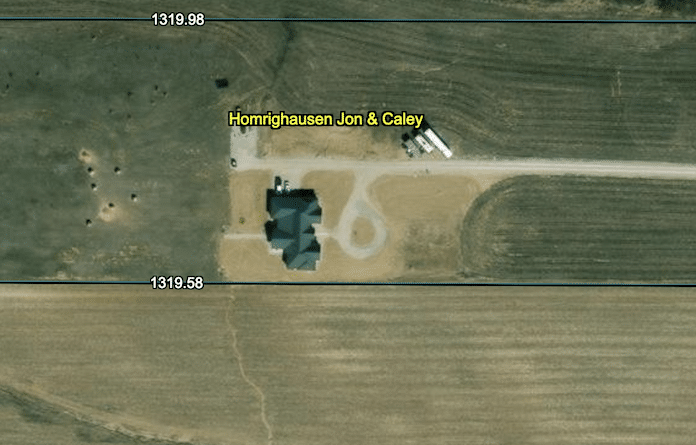Fiasco over 4 feet

A hardship variance was denied Monday night by the Monroe County Zoning Board of Appeals for John and Caley Homrighausen, who have spent the last year seeking to be able to legally occupy their home in rural Waterloo.
Their request for a hardship variance was denied earlier this month by the Monroe County Planning Commission as it failed to gain a recommendation of approval to the board of appeals by a vote of 7-5.
Monroe County officials did not issue a final inspection or occupancy permit last year after it was realized part of the couple’s nearly-completed residence on H Road was 16 feet away from the property line rather than the required 20 feet.
The Homrighausens’ request for a variance was denied by the board of appeals last year, and they agreed to work with neighboring property owner Josh Biffar in an attempt to address the situation without official action by the county.
Biffar, a farmer, expressed disapproval with the variance at that meeting last year, saying he was hesitant given the potential liability for overspray of crop chemicals affecting the house’s siding.
Since then, Caley was cited 14 times by the county in 2024 for “knowingly residing in a building without final certificate of zoning compliance” at this property, and pleaded guilty to the original violation on May 27 and paying a fine of $600.
The new variance pursuit by the Homrighausens is specifically for a hardship variance, with the couple stating denial of an occupancy permit has created an undue difficulty on their family.
Hardship variances are generally applicable in cases which enforcement of an ordinance does not create a burden on the public or surrounding property owners, is specific to the property in question and is not “self-created.”
Thus, the board of appeals found themselves once again presented with the Homrighausen house issue Monday night.
Prior to the matter being addressed, a letter from the Homrighausens was read as part of the item’s correspondence.
The letter outlines the situation and notes that the couple were advised to come to an agreement with Biffar, going on to say that, “After paying the retainer fee for our neighbor’s lawyer of choice and much back and forth, we are unable to come to an agreement with our neighbor.”
It goes on to note five potential solutions to the problem that were found to be infeasible.
The first of these was purchasing 10 feet into Biffar’s land all along the length of the property. With the neighboring property apparently selling for $17,500 per acre, the couple offered $5,250 and any survey fees for the 0.3 acres, with Biffar reportedly countering at $300,000.
Purchasing land from others nearby was seemingly not possible, nor was the original pursuit of a variance.
Another failed solution was giving Biffar acreage at the front and back of the property amounting to over seven acres plus $25,000.
The couple seemingly then moved to liability paperwork with Biffar, paying his lawyer fees and their lawyer to draft paperwork, though they say Biffar “did not think the county would be able to record said paperwork and backed out.”
The letter goes on to say the last offer from the Homrighausens was to purchase 10 feet in and 70 feet wide of Biffar’s property for $10,001, with a 99-year lease for $1 that Biffar could continue farming the land, along with the liability paperwork – though they were instructed by Biffar’s lawyer that the offer was declined, and he did not wish to negotiate further.
Additionally, the letter states, “Granting this variance will not have much effect, if any, on Mr. Biffar’s property or any of the surrounding properties. As the liability paperwork that Mr. Biffar and his lawyer reviewed many times, much of the concern of our home being four feet too close was that Mr. Biffar would incur liability, and listed no concerns of us doing any damage to his property. We have also angled out downspouts in such a way that the majority of the water flows away from his property.”
The letter continues by saying the Homrighausens have looked into having the house lifted on stilts and moved, but the cost of this project would be close to a quarter of a million dollars.
The couple’s lawyer, Anthony Gilbreth, addressed the board on their behalf during the meeting, joined by Caley, who spoke first.
She said the foundation of the house had originally been inspected by the county, and the setback issue was not mentioned until an inspection that took place much later in the construction process.
Caley went on to speak about the money that has gone toward legal fees and other payments as a result of this issue, further discussing her and her husband’s attempts at working with Biffar.
She also emphasized that the problem is centered around a setback rather than a property line.
“If this variance is granted, nothing changes except that a portion of our home will be four feet beyond a line on a map but not in the property boundary,” Caley said. “We have exhausted every possibility reasonable and unreasonable trying to fix this. We have asked everyone we can think of for ideas and support, and now we are asking you to grant a variance to avoid unnecessary hardship to our family.”
Gilbreth went on to address the board for some time, touching on the negotiation attempts with Biffar but ultimately stressing that discussion and the board’s decision should be focused on the hardship placed on the Homrighausens.
“The focus, I think, for this board needs to be on the purpose and the objective of granting variances,” Gilbreth said. “The code states that the board shall not grant a variance unless the variance is consistent with the general purposes of the code. We have a residential building on a residential lot that is four feet too close to a property line. We’re not over a property line. We’re over a setback.”
He commented the property would be unmarketable without a variance, also alluding to KB Contracting and Mike Thomas, who handled the house’s construction, as the couple were seemingly informed the building would be in compliance with county code.
In this same vein, Gilbreth noted construction was not halted by the county – though that wouldn’t have been desirable regardless.
He further expressed the couple is not indifferent to the situation, but they’ve done what they could to cooperate.
Gilbreth then responded to questions from the board largely focused on why litigation hasn’t been filed against Thomas if there is suspicion of negligence, with Gilbreth responding that any potential compensation from such litigation wouldn’t be able to address the core setback problem.
“The remedy’s not gonna move it,” Gilbreth said. “It’s gonna get some money, maybe, out of the situation, but it’s still not gonna move the structure.”
Focus then turned to the failure to reach an agreement between the Homrighausens and Biffar.
This discussion largely referred back to the last few negotiations between these parties.
As a final counteroffer, Biffar was willing to agree to $625,000 per acre – a figure that the Homrighausens had introduced – for a straight line from the front to the back of the property alongside an indemnity agreement, surveying expenses and the installation of a basin due to erosion issues caused by the house seemingly being too close to the property line.
It was noted the $625,000 figure was originally used to arrive at the offer of $10,001 for the purchase of 700 square feet into Biffar’s property, though Biffar was firm that any property changes would run the entire length of the property.
On the basin, Gilbreth questioned the inclusion of this item in the offer, with Monroe County Building Inspector and Zoning Administrator Chris Voelker saying it wasn’t required.
Mary Biffar, who said she owns a neighboring property and works with Josh, offered her thoughts on the negotiation process.
“There was a couple things in that contract that we just weren’t able to come to an agreement on,” Mary said. “Mostly, it was kind of a C-shaped field at the end of it when it would be cut up, and I know they tried real hard for the liability and some of the other things, but we just wanted a clean break. So I kind of disagree. I don’t think we tried real hard. The last two offers were kinda the same, cookie-cutter.”
Josh also spoke, expressing a similar sentiment about the negotiations.
“The last two offers was basically the exact same thing,” Josh said. “I didn’t set the price for the price per acre. He was the one that gave that to me. I’ve stated for the last year that I’ve wanted a straight line in this.”
Josh also spoke about erosion issues he’s seen on his property and noted his concerns of future issues with his farming operations with their house being so close to his land.
“Their children, their dogs, their toys are over in my field all the time,” Josh said. “How much more will that be whenever they actually own the property, and what kind of problems will I entail still farming a piece of their property and driving through?”
He urged the board to deny the variance, saying the problem was self-inflicted as the Homrighausens had 10 acres to work with and decided to have the house built that close to the property line.
Josh suggested that, were the variance to be approved, he could face another problem as he would have to abide by certain setback restrictions were he to have any building constructed on the property – though it’s unclear how significant an impact the four feet variance would have on such a project.
While a substantial portion of the meeting from there was spent discussing the negotiation process between the parties, the subject was later brought back to the variance itself, with Gilbreth saying approval would not be precedent-setting as the cases are considered on an individual basis. He further said the zoning board didn’t need to make an example of the Homrighausens.
Regarding negotiations, he said the parties seem to be “talking past each other” given how far apart they are in their wishes, though he did suggest some agreement might be possible.
“I know that I have tried to cut a deal for the better part of six months on a relatively simple situation,” Gilbreth said. “I’m not optimistic, but I never say never. I really don’t.”
Ultimately, the board failed to carry the motion, and the variance was denied.
Voting in approval of granting the variance were board members Russell Gregson, George Obernagel and Mike Kovarik. Vicki Taake and Brian Coats voted against.
Following the meeting, the Republic-Times spoke with Thomas, who recalled the setback issue had been discovered fairly close to the building’s completion when Josh reached out to the county about the matter.
Thomas explained that, though he was involved in the project at the start, the Homrighausens seemingly worked with another contractor before returning to KB Contracting. Thomas said he returned to the project after the surveying work, property markings and initial site work had been completed.
Like Caley and Gilbreth, he placed emphasis on the fact the house still lies behind the property line. He further questioned why the variance would be denied given the apparent hardship.
“I think the actual issue is kinda being overlooked,” Thomas said. “The Homrighausens’ house is still on their property. It’s 16 feet, according to the county, on their property. It’s just unfortunate that somebody’s house can still be within their property – I understand setback restrictions – but there’s no neighboring house. There’s just nothing there.”
As discussed throughout the board of appeals meeting, the Homrighausens have a number of options before them, ranging from making another appeal to place the matter in Monroe County Circuit Court to reaching an agreement with Josh to moving their house or cutting off the portion of the house in conflict with the setback – though any solution would seem to lead to further cost.






